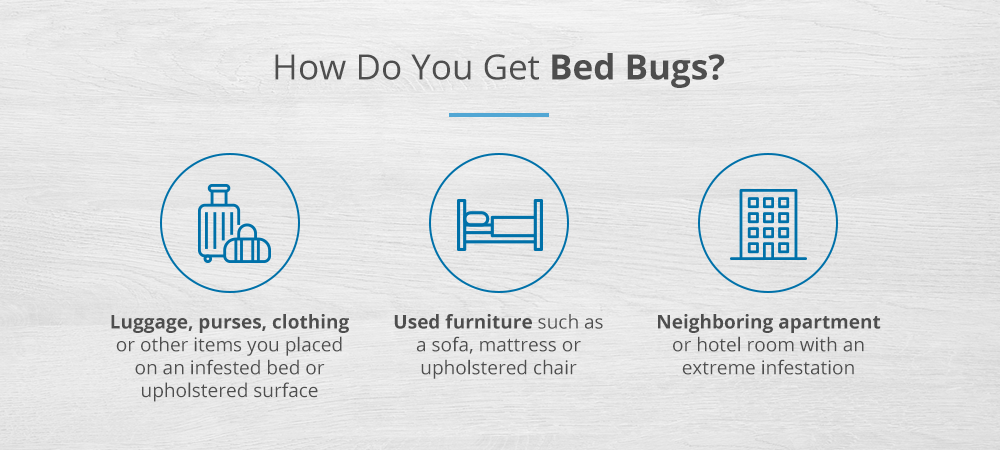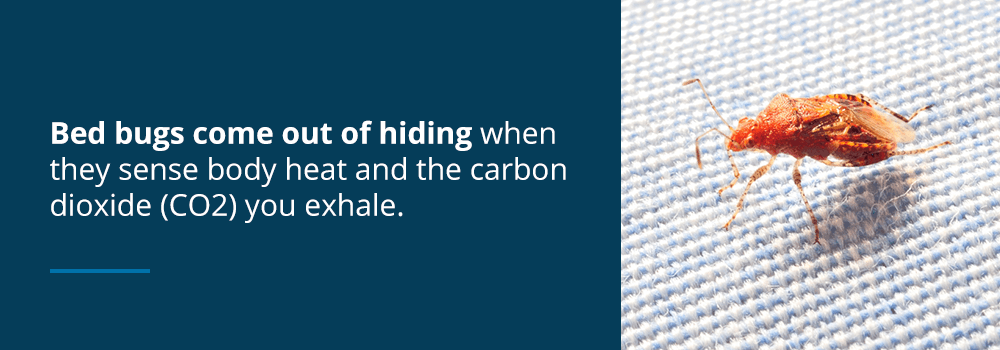Chapter 3: Where Do Bed Bugs Come From?
Since bed bugs are sneaky, you might not realize they hitched a ride to your house. That’s why it’s essential to know how bed bugs spread and where they hide so that you can take action immediately.
In this chapter, we’ll explore how these uninvited guests commonly get inside, and where they like to spend their time. Even if bed bugs managed to get into your house, know it’s not too late to control the situation. At Pestech Pest Solutions, we’re here to help.
Contact Pestech Today
How Do You Get Bed Bugs?

Many people think of dirt and clutter when they think about bugs. Bed bugs are attracted to our breath and blood — they don’t care about cleanliness. The main cause of bed bugs is bringing them inside from an infested location.
Bed bugs may enter your home in any of the following ways:
- Luggage, purses, clothing or other items you placed on an infested bed or upholstered surface
- Used furniture such as a sofa, mattress or upholstered chair
- Neighboring apartment or hotel room with an extreme infestation
Can Bed Bugs Spread From One Person to Another?
Bed bugs do not live on people, so they cannot spread directly from one person to another. However, they could get into someone’s belongings, such as a purse or backpack, and spread into your home that way. Nevertheless, it’s more likely you’d get an infestation by transporting bed bugs into your home by staying in an infested room.
Do Bed Bugs Travel on People’s Clothes?
It’s not likely bed bugs travel on the clothes people are wearing. People do not make good hiding spots, and they move too much. Since bed bugs can’t jump or fly, you wouldn’t have to worry about them hopping onto you from another person or an infested item anyway.
Another reason bed bugs aren’t likely to travel on someone’s clothes, or their body in general, is they don’t like heat. Although they don’t mind dealing with bodily heat for a few minutes as they dine, they prefer to avoid it otherwise, and therefore, would rather not hide close to someone’s skin.
Where Do Bed Bugs Hide?
Bed bugs like to hide near any sleeping or resting area, whether that be a bed, sofa or recliner. An infestation typically starts in one room and then spreads to other places where people sleep. They prefer to stay close to their host’s bed, but if it’s too crowded, they’ll hide anywhere. Overall, here is where you’ll most likely find bed bugs:
- Bed frames
- Headboards
- Mattress seams
- Box springs
In heavily infested homes, bed bugs need to be more creative and go wherever there’s room. With a severe infestation, you might find bed bugs:
- In the folds of curtains
- Between couch cushions
- Under wall hangings
- In furniture joints
- In chair or sofa seams
- In electrical appliances
- Along window frames or electrical outlets
Since bed bugs have tiny, flat bodies, they can hide in the smallest places, including the head of a screw.
What Brings Bed Bugs out of Hiding?

Bed bugs come out of hiding when they sense body heat and the carbon dioxide (CO2) you exhale. Both of these elements signify a blood meal. There are a few ways to force bed bugs out of hiding using heat and CO2, such as:
- Use a hairdryer: Use the lowest setting on a hairdryer and carefully blow hot air into cracks and crevices. Be sure to crush any bed bugs that come out with a paper towel, or remove them with a vacuum attachment. Place the vacuum bag or contents in a sealed plastic bag and throw it in the trash outside your home.
- Try a monitoring trap: You can use a bed bug monitoring tool to trap and detect bed bugs. For example, you might place interceptor traps under the legs of the bed or furniture. This simple trap captures bed bugs trying to climb onto or down from a piece of furniture. You can also make a dry ice trap or a sugar-yeast trap that would lure bed bugs by releasing CO2.
No matter what method you test, keep in mind that you’re only trying to detect bed bugs. You’ll still need to treat the infestation if you find bugs.
Do Bed Bugs Live in Pillows?
Bed bugs can live in pillows as long as they can hide and stay near a host. However, they don’t prefer to live in pillows and would rather reside somewhere darker and quieter.
Where Should You Sleep If You Have Bed Bugs?
If you’ve discovered bed bugs, it’s understandable if you want to avoid sleeping in the room where you found them. While this might be OK for a couple of nights, you’ll eventually want to go back to your room if you can manage anxious feelings until you contact a pro. If you begin to sleep on the couch or in a different bedroom, bed bugs will get hungry and look for you, causing the infestation to spread. It’s easier to control a bed bug problem in one area than several rooms.
